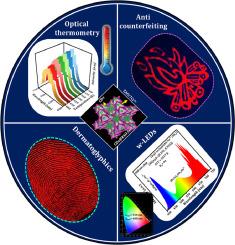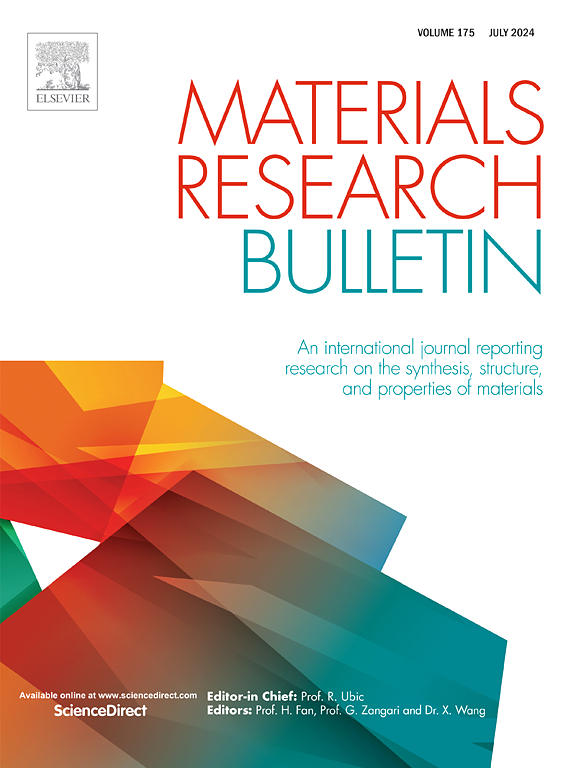碳点和氯化物通量改性 ZnAl2O4:Cr3+ 纳米磷酸盐在温度传感、尖端法医、防伪和 w-LED 应用中的比较研究
IF 5.3
3区 材料科学
Q2 MATERIALS SCIENCE, MULTIDISCIPLINARY
引用次数: 0
摘要
通过固态反应方法,将碳点(CD)和氯化物通量(NaCl、KCl、NH4Cl)接枝合成了一种新型的掺杂 Cr3+ 的 ZnAl2O4。在 530 nm 波长的激发下,ZAO NPs 中的 Cr3+ 离子在强晶场的影响下发出红光。这种红色发射来自 Cr3+ 离子的电偶极子 2Eg→4A2g。在所研究的氯化物通量中,NH4Cl 对聚光强度有显著影响。值得注意的是,当在ZAO:7Cr3+/NH4Cl NP 中加入 CD 时,光致发光(PL)强度显著增加了 17.25 倍。这种增强大大高于单独使用 CD(11.23 倍)和单独使用 NH4Cl(3.82 倍)时的增强。PL 强度的增加归因于佛斯特共振能量转移(FRET)机制。此外,加入 CD(5 wt.%)后,ZAO:7Cr3+/NH4Cl NCs 的色纯度(CP)提高到 99.8%,内部量子效率(IQE)高达 93.4%。值得注意的是,CDs(5 wt.%)@ZAO:7Cr3+/NH4Cl NCs 即使在 420 K 下也能保持 92.43% 的发射强度,与ZAO:7Cr3+ NPs 相比,表现出卓越的热稳定性。此外,这种 NPs 还有望用于光学温度测量,在 300 至 480 K 的温度范围内具有 6.74 × 10-2 %K-1 的高相对灵敏度 (Sr)。在紫外线照射下,I-III 级 LFP 的结构特征清晰可见。此外,CDs(5 wt.%)@ZAO:7Cr3+/NH4Cl NCs 发出的强烈红色荧光使其适合应用于交流电。CDs(5 wt.%)@ZAO:7Cr3+NCs在w-LED制造方面表现出巨大的潜力,其相关色温(CCT)达到 5517 K,CIE 坐标为(0.332,0.331),显色指数(CRI)高达 Ra = 94,优于ZAO:7Cr3+/NH4Cl NPs。总体结果清楚地表明,CDs(5 wt.%)@ZAO:7Cr3+/NH4Cl NCs 可有效地应用于光学温度计、腕镜、w-LED 和交流电。本文章由计算机程序翻译,如有差异,请以英文原文为准。

Comparative investigation on carbon dots and chloride fluxes modified ZnAl2O4:Cr3+ nanophosphors for temperature sensing, cutting-edge forensic, anti-counterfeiting and w-LEDs applications
A novel Cr3+ doped ZnAl2O4 is synthesized by grafting carbon dots (CDs) and chloride fluxes (NaCl, KCl, NH4Cl) through the solid-state reaction method. Upon excitation at 530 nm wavelength, the Cr3+ ions in the ZAO NPs emit red light due to the influence of a strong crystal field. This red emission arises from the electric dipole 2Eg→4A2g of the Cr3+ ions. Among the chloride fluxes examined, NH4Cl had a significant impact on the PL intensity. Notably, when CDs are incorporated into the ZAO:7Cr3+/NH4Cl NPs, a remarkable increase of 17.25-folds in photoluminescence (PL) intensity is observed. This enhancement is substantially higher than that of CDs alone (11.23-folds) and NH4Cl alone (3.82-folds). The increased PL intensity is attributed to the Förster resonance energy transfer (FRET) mechanism. Furthermore, the addition of CDs (5 wt.%) enhanced the colour purity (CP) of ZAO:7Cr3+/NH4Cl NCs to 99.8%, achieving a high Internal quantum efficiency (IQE) of 93.4 %. Notably, the CDs (5 wt.%)@ZAO:7Cr3+/NH4Cl NCs maintained 92.43 % of their emission intensity even at 420 K, demonstrating exceptional thermal stability compared to ZAO:7Cr3+ NPs. Moreover, the NPs holds promise for optical thermometry, boasting a high relative sensitivity (Sr) of 6.74 × 10–2 %K-1 across a temperature range spanning from 300 to 480 K. Moreover, the latent fingerprints (LFPs) developed using CDs(5 wt.%)@ZAO:7Cr3+/NH4Cl NCs demonstrate remarkable selectivity and high contrast. Under UV irradiation, the structural features of LFPs at levels I–III are clearly visible. In addition, the strong red fluorescence emitted by CDs(5 wt.%)@ZAO:7Cr3+/NH4Cl NCs makes them suitable for applications in AC. CDs(5 wt.%)@ZAO:7Cr3+ NCs exhibit significant potential for w-LED fabrication, achieving a correlated colour temperature (CCT) of 5517 K, a CIE coordinate of (0.332, 0.331), and a high colour rendering index (CRI) of Ra = 94, outperforming ZAO:7Cr3+/NH4Cl NPs. Overall results clearly demonstrates that, CDs(5 wt.%)@ZAO:7Cr3+/NH4Cl NCs are effective for applications in optical thermometry, dactyloscopy, w-LEDs, and AC.
求助全文
通过发布文献求助,成功后即可免费获取论文全文。
去求助
来源期刊

Materials Research Bulletin
工程技术-材料科学:综合
CiteScore
9.80
自引率
5.60%
发文量
372
审稿时长
42 days
期刊介绍:
Materials Research Bulletin is an international journal reporting high-impact research on processing-structure-property relationships in functional materials and nanomaterials with interesting electronic, magnetic, optical, thermal, mechanical or catalytic properties. Papers purely on thermodynamics or theoretical calculations (e.g., density functional theory) do not fall within the scope of the journal unless they also demonstrate a clear link to physical properties. Topics covered include functional materials (e.g., dielectrics, pyroelectrics, piezoelectrics, ferroelectrics, relaxors, thermoelectrics, etc.); electrochemistry and solid-state ionics (e.g., photovoltaics, batteries, sensors, and fuel cells); nanomaterials, graphene, and nanocomposites; luminescence and photocatalysis; crystal-structure and defect-structure analysis; novel electronics; non-crystalline solids; flexible electronics; protein-material interactions; and polymeric ion-exchange membranes.
 求助内容:
求助内容: 应助结果提醒方式:
应助结果提醒方式:


